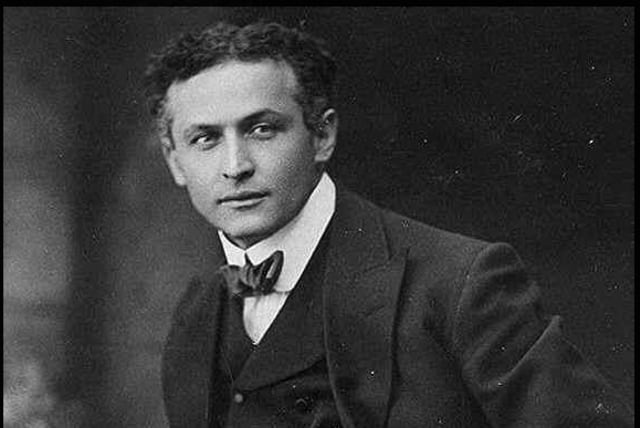Houdini: The rabbi's son who mesmerized the world

150 years since the great illusionist’s birth, the ‘Post’ dips into the little-known family connections of Harry Houdini
Elvis. Brando. Kobe. Some people become so famous, embodying their trade so perfectly that only one noun suffices, and we automatically know who is being referenced. Houdini is one such name.
The greatest magician, illusionist, and escape artist of all time, Harry Houdini, was born 150 years ago last Sunday, March 24, as Erik Weisz into a Jewish family in Budapest, then in the Austro-Hungarian Empire. The Weisz family moved to America in the mid-1870s, settling in Appleton, Wisconsin, where his father, Mayer Samuel, helped found the town's first synagogue and became its first rabbi.
"They came to America to find a new life, and Houdini always told people that his father was a rabbi and that he came from a long line of learned people," John Cox, a Houdini expert and historian, told The Jerusalem Post about Houdini's connection to his religion.
"He wasn't super observant, but he would follow customs. He always said the Kaddish prayer on the anniversary of his father's death. No matter where he was in the world, even if he had to travel, he would find a temple and say Kaddish on his father’s yahrzeit.”
One anecdote, shared by Houdini historian David Saltman, reveals the honor and esteem Houdini held his father in.
After moving to New York and facing financial hardship in 1890, Rabbi Weisz sought aid from a Rabbi Drachman, a scholar who taught the young Houdini. Rather than accepting monetary assistance, Weisz offered Drachman his set of Codes of Maimonides from his impressive Hebrew library, which Drachman purchased. Years later, after Weisz passed away and his son achieved fame and fortune, Rabbi Drachman approached Houdini for a donation to clear his synagogue's mortgage.
Houdini agreed, but on the condition that he retrieve the set of Maimonides books as a memento of his father. Rabbi Drachman acquiesced, and upon receiving the books, Houdini sent a generous donation of $500. At Houdini's funeral, Rabbi Drachman reflected on his remarkable power and character, affirming him as one of the great figures of his time.
Like all good Jewish boys, Houdini was also particularly tenacious in caring for his mother, something he pledged to his father on his deathbed.
"People called him a mama's boy, but he did have a very close relationship with his mother," Cox comments. As Houdini's stock began to rise in Europe following a 1900 tour that included acclaimed jailbreaks from London's Scotland Yard, he lavished his mother with a dress originally made for Queen Victoria.
"All the letters he exchanged with his mother were buried with him," Cox explains. His instructions were to take her letters, make a pillow, and place that under my head in my casket, which is what happened. Unfortunately, it means we have no letters between them."
To be buried with his mother's letters shows a side of Houdini that helped keep the air of mystery and the unknown, which is the illusionist's greatest challenge—keeping the magic alive.
Necessity breeds innovation
As the young Houdini passed adolescence in New York, he learned that to elevate himself from poverty, he must think bolder and bigger than anyone had ever done. From breaking out of handcuffs, his acts evolved to include jumping off bridges in handcuffs and being suspended upside down in straitjackets (particularly outside newspaper offices, which guaranteed publicity) before he hit the jackpot—the most audacious and dangerous trick of all.
In 1912, he introduced his most perilous act, The Water Torture Cell, which became his signature. Suspended upside down with his feet secured, Houdini would be lowered into a tank of water, initially enclosed in a steel cage. The dramatic escape, performed to the tune of "The Diver," involved Houdini emerging free from a concealed cabinet while the cell remained locked. The apparatus, constructed in England, was a complex and costly structure made of mahogany, steel, and glass, weighing nearly three-quarters of a ton and holding 250 gallons of water.
To stand above the crowd was something that Houdini recognized early on in his career, as his use of newspapers shows. He was the ultimate showman.
"I want to be first, I vehemently want to be first," Houdini said candidly in an interview in his later years. "So, I have struggled and fought. I have done and abstained; I have tortured my body and risked my life only for that- to have one plank on the stage where the imitators cannot come and one spot where they all fall back and cry, 'Master!'"
One of the greatest accolades that can perhaps be achieved in any field is to be held in such esteem by one's peers. The pedestal that Houdini sits atop within the illusionist world is his and his alone. Throughout his career, Houdini may have escaped from straitjackets, jail cells, and water torture chambers. But it seems unlikely he will ever escape from the public's imagination.
Jerusalem Post Store
`; document.getElementById("linkPremium").innerHTML = cont; var divWithLink = document.getElementById("premium-link"); if (divWithLink !== null && divWithLink !== 'undefined') { divWithLink.style.border = "solid 1px #cb0f3e"; divWithLink.style.textAlign = "center"; divWithLink.style.marginBottom = "15px"; divWithLink.style.marginTop = "15px"; divWithLink.style.width = "100%"; divWithLink.style.backgroundColor = "#122952"; divWithLink.style.color = "#ffffff"; divWithLink.style.lineHeight = "1.5"; } } (function (v, i) { });

